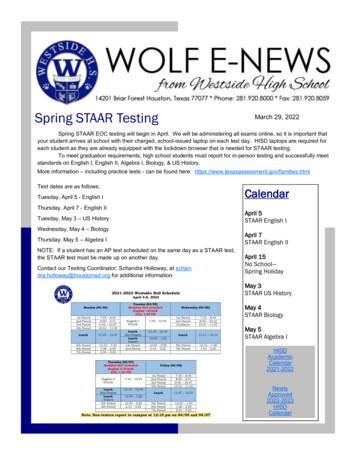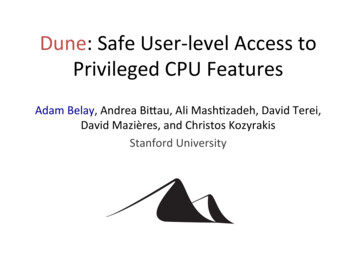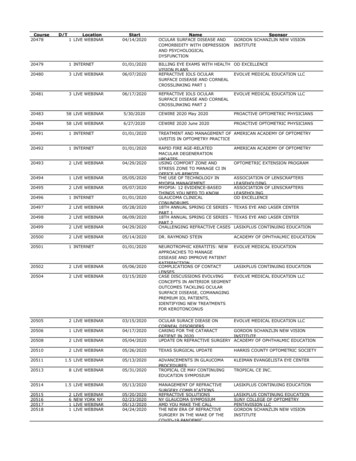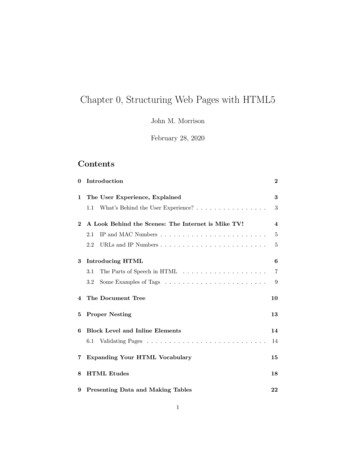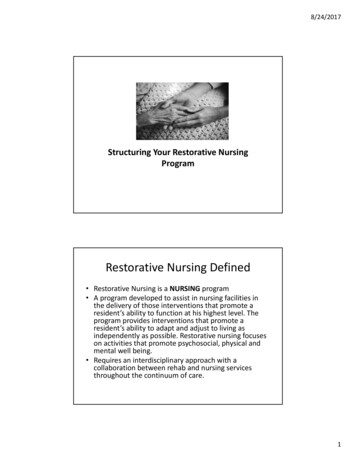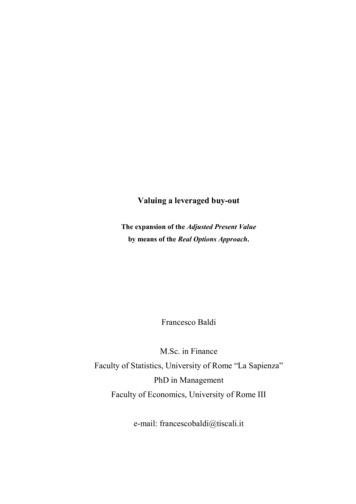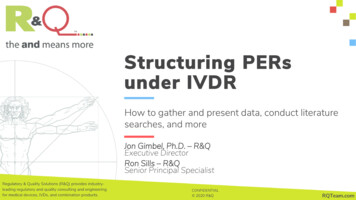
Transcription
Structuring PERsunder IVDRHow to gather and present data, conduct literaturesearches, and moreJon Gimbel, Ph.D. – R&QExecutive DirectorRon Sills – R&QSenior Principal Specialist
ServicesMay 2020 / May 2022 Regulatory Worldwide regulatorystrategy and supportFDA regulatory submissions(510(k), PMA, De Novo, etc.)EU MDR and IVDRtechnical documentationCERs and PERsRegulatory complianceAcquisition integrationEU MDR / IVDRQuality SystemsExpert implementers experienced withmultinational companies transitioning to the EUMDR and IVDR Validated EU MDR / IVDR transition process,procedures, and toolsMock EU MDR and IVDR audits FDA and MDSAP inspectionreadiness and supportAcquisition integrationQuality system development /improvement: ISO 13485, QSR,EU MDR, IVDR Internal and supplier auditing QualityAssurance Best-in-class project management and SMEsfor all workstreamsFull service or just what you needofferings, including plandevelopment, literature search andreviews, and report writing (CER /PER, CEP / PEP, PMCF/PMPF,SSCP/SSP) Implementation of PMS / PMCF processes andplansAll clinical specialties and deviceclassifications Former notified body senior leadership on staffCapacity for 100's of CERs (nooffshoring) Strong notified body and ation Design quality engineeringand assurance Scalable team: strategic,tactical, and creative Safety risk management,including recall decisions andstrategy DHF and technical documentationremediation Manufacturing site transferComplaint files and device reporting Manufacturing quality483, warning letter, consent decreeresponses and execution NB non-conformity report correctiveaction plans and executionCONFIDENTIAL 2020 R&QCERs / PERs Analysis of data and creation ofPMS / PMCF / PMPF Plansand ReportsPMS/CER/Risk integration, includingprocess and operational teamalignmentRQTeam.comProject Management Across all R&Q projects Best-in-class, PMP-certifiedproject managers Seasoned device professionalsexclusively focused on RA/QA2
About Remote and Flex-CORE supportAvailable across all R&Q services.CONFIDENTIAL 2020 R&QRQTeam.com3
Questions Thank you for your questionssubmitted during registration! You are still able to ask questionsduring the webinar and they may beanswered in the follow-up Q&A Answers to some questions will beshared on webinar resources page If you have a question after thewebinar, you can still emailintel@rqteam.com Reminder: you will be notified via emailwhen the slides and webinar recordingare available (within 24 hours)CONFIDENTIAL 2020 R&QRQTeam.com4
Jon Gimbel, Ph.D. – R&Q Executive Director and CERBusiness Unit Lead Ph.D. in Mechanical Engineering 20 years of medical deviceresearch, design/development,regulatory, and quality systemexperienceCONFIDENTIAL 2020 R&QRQTeam.com5
Ron Sills – R&Q Senior Principal Specialist Joined R&Q in early 2019; former LeadAuditor at TUV Rheinland Authorizations for ISO 13485, ISO 9001,MDD, IVDD, CMDCAS and MDSAP Expert on sterilization technologies andvalidation, hygiene and clean roomcertification, and biocompatibility Has developed clinical evaluation reportservices, as well as providing expertresearch services for clients in the medicaldevices, pharmaceutical, and life sciencesindustriesCONFIDENTIAL 2020 R&QRQTeam.com6
Overview of today’s contentPerformance Evaluation PlanPerformance Evaluation ReportStructure tipsContents and section tipsLiterature search protocol tipsPMPFQuestionsCONFIDENTIAL 2020 R&QRQTeam.com7
Objective of the IVDR 2017/746 However a fundamental revision of that Directive(98/79/EC) is needed to establish a robust, transparent,predictable and sustainable regulatory framework for in vitrodiagnostic medical devices which ensures a high level ofsafety and health whilst supporting innovation.When interpreting the regulation, remember the objective.Does it make it more transparent? Does it provide a high level ofsafety and health? Those questions will help guide yourinterpretation.CONFIDENTIAL 2020 R&QRQTeam.com8
IVDD to IVDR transition timelineIVDDCertificates VoidMay 27, 2024YOU ARE HEREDate of ApplicationMay 26, 2022Adoption of IVDR& Entry into ForceMay 2017201820172019No more“makingavailable orputting intoservice”May 20252020202120222023202420252026Transition Period from IVDD to IVDRIVDR CertificatesCONFIDENTIAL 2020 R&QRQTeam.comSource: BSI Group, IVDD to IVDR Timeline, bsigroup.com9
Increased Emphasis on Clinical EvidenceCONFIDENTIAL 2020 R&QGreater scrutiny of Notified BodiesCompetent Authorities and Reference Laboratories involved in conformityassessment of high-risk devices resulting in elongated conformityassessment procedures. Tighter designation rules for NBs may lead to areduced number of NBs available.No "grandfathering" provisionsAll currently approved IVDs must be recertified in accordance with thenew requirements. Manufacturers with currently approved devices willhave five years to demonstrate compliance with the IVDR’s newrequirements.Increased Notified Body involvementReviews will be more focused and the requirements fordesignation and monitoring of Notified Bodies underIVDR will be considerably tightened.More stringent requirements regardingtechnical documentation and clinical evidenceContents of the technical documentation require evidenceof safety and performance proportionate with a device’sassigned risk class.RQTeam.com10
Pillars of PerformanceCONFIDENTIAL 2020 R&QRQTeam.com11
Clinical Evidence andPerformance Evaluation Pre-market performance evaluation and clinical evidence nowexplicitly required in the regulation New plans and reports are introduced (e.g., performanceevaluation plan, performance evaluation report, PMPF plan, ) Requirements similar to EU MDR and GHTF documents GHTF/SG5/N6:2012 Clinical Evidence for IVD Medical Devices – KeyDefinitions and Concepts GHTF/SG5/N7:2012 Clinical Evidence for IVD Medical Devices –Scientific Validity Determination and Performance Evaluation GHTF/SG5/N8:2012 Clinical Performance Studies for In Vitro DiagnosticMedical Devices MEDDEV 2.7/1 Rev 4 Clinical Evaluation for Medical DevicesCONFIDENTIAL 2020 R&QRQTeam.com12
Performance Evaluation Process(Annex XIII) Performance Evaluation Plan(Annex XIII Part A 1.1) Performance Evaluation Report(Annex XIII 1.3.2)PerformanceEvaluation Plan Scientific validity report(Annex XIII Part A 1.2.1) Analytical performance report(Annex XIII Part A 1.2.2) Clinical performance report(Annex XIII Part A 1.2.3) Conclusions drawn from assessmentof the clinical evidence(Article 56.3; Annex XIII 1.3.1)PMS andPMPFPerformanceEvaluationReport PMS and PMPF Plans and ReportsCONFIDENTIAL 2020 R&QRQTeam.com13
CER Structure – MEDDEV 2.7/1 rev 4 A9 Summary Scope and device description Clinical background and State of theArt Device under evaluation Demonstration of equivalenceNon-clinical dataClinical Investigation dataPMS / PMCF dataClinical literature data Analysis of the clinical data Conclusions and additionalinformationCONFIDENTIAL 2020 R&QRQTeam.com14
CER vs. PER StructureCER Summary Scope and device description Clinical background and State of theArt Device under evaluation Demonstration of equivalenceNon-clinical dataClinical investigation dataPMS / PMCF dataClinical literature data Analysis of the clinical data Conclusions and additionalinformationCONFIDENTIAL 2020 R&QPERSummaryScope and device descriptionLiterature searchClinical background and State of theArt Device under evaluation Demonstration of equivalenceScientific validity reportAnalytical performance reportClinical performance report Analysis of the clinical evidence Conclusions and additionalinformationRQTeam.com15
Performance Evaluation Plan(Annex XIII, Part A) Intended purpose, intended use, target patient groups, indications, limitations and contra-indications Characteristics of the device Analyte or marker to be determined by the device Identification of reference materials or reference measurement procedures for metrological traceability Identification of the relevant GSPRs Methods, including the statistical tools, used for the examination of performance Description of the state of the art Parameters to be used to determine the acceptability of the benefit-risk ratio For software, reference databases and other sources of data used as the basis for its decision making Outline of development phases including milestones and acceptance criteria PMPF plansTIP: The Performance Evaluation Plan should be a separate document.CONFIDENTIAL 2020 R&QRQTeam.com16
Structure of a PEP Executive Summary, Introduction, and Objectives Device Description Characteristics of the deviceSpecification of the Analyte or MarkerPerformance CharacteristicsIntended Purpose, Intended Use, and ClaimsIndications, Target Patient GroupsContraindications, Limitations, Precautions, WarningsIntended User / EnvironmentBenefitsRisk Management and Labeling Scope Identification of the Device Manufacturer Classification Status of CE Mark and Market HistoryTIPS: Align PEP and Annex II Technical Documentation content Intended use should be directly from IFUCONFIDENTIAL 2020 R&QRQTeam.com17
Structure of a PEP Literature Search Protocol State of the Art Standards, CSs, GuidanceDocuments, and BestPractice Documents Description of State of the Art CONFIDENTIAL 2020 R&QTIPS: Provide brief overview of SotA Standard and CSs should alignwith technical documentation Diagnostic alternatives andsimilar devices should informliterature searchMedical ConditionDiagnostic AlternativesSimilar DevicesSummary and ConclusionsRQTeam.com18
Structure of a PEP Demonstration of Equivalence Scientific Validity Plan Context and Type of Evaluation Data Sources Analytical Performance Plan Context and Type of Evaluation Parameters and methods used to evaluateperformance Data Sources Clinical Performance Plan Context and Type of Evaluation Parameters and methods used to evaluateperformance Data SourcesCONFIDENTIAL 2020 R&QRQTeam.comTIPS: Equivalent device should beidentified at this stage (informsliterature search) Equivalence should be based onsimilar technology andmethodology and the same analyteand intended purpose Data sources may be different foreach section All reports may include literaturedata19
Structure of a PEP Analysis of Clinical Evidence Performance and Benefits (GSPR 1,9) Safety and Risks (GSPR 1, 9) Benefit/Risk Profile and UndesirableEffects (GSPR 1, 8) Development PhasesPMS and PMPF PlansFrequency of UpdatesQualificationsReferences / Source DocumentsCONFIDENTIAL 2020 R&QRQTeam.comTIPS: See Article 56.1 for GSPRreferences PMS/PMPF plans will beupdated after evaluation Refer to MEDDEV 2.7/1 Section6.4 for concepts regardingqualifications and updatefrequency High risk – annually Lower risk – every 2-5 years Class C and D device updatedannually20
Systematic Literature Search Process Literature search protocol Search terms and databases Inclusion / exclusion criteria Appraisal criteria Execute the search Screening of articles usinginclusion-exclusion criteria Appraisal Summary and analysisCONFIDENTIAL 2020 R&QGHTF/SG5/N7:2012 Appendix BRQTeam.com21
Literature Search Protocol Introduction and Objectives Purpose of the search Reference to guidance documents Identification of Device(s) Devices covered by search Indications and claimsTIPS: Refer to the following for information on literaturesearch protocols: MEDDEV 2.7/1 Rev 4 A5 IMDRF MDCE WG/N56FINAL:2019 GHTF/SG5/N7:2012 Attach protocol to PEPCONFIDENTIAL 2020 R&QRQTeam.com22
Literature Search Protocol MethodsTIPS: Use Google Scholar to ensuresearch is capturing relevant articles General search terms can beincluded in protocol; Actual searchterms should be included in PER Search should cover initial CE markto the present State of the art will require differentsearch terms than performancesearches Databases PubMed Embase Google scholar Search strategy Search terms Operators Date rangeCONFIDENTIAL 2020 R&QRQTeam.com23
Literature Search Protocol MethodsState of the Art Systematic reviews, meta-analyses orcomparative studies Clinical practice guidelines, guidancedocuments, and textbooks High quality clinical studies on similardevices and alternatives Literature selection process Inclusion criteria Exclusion criteria AppraisalScientific Validity Peer reviewed studies or guidancedocuments applicable to scientificvalidity of analyte Suitability ContributionPerformance Evaluation Analytical or clinical performancestudies on subject device Clinical studies with safety andperformance data for subject device Other clinical experience dataCONFIDENTIAL 2020 R&QRQTeam.com24
Literature Search ProtocolIMDRF MDCE WG/N56FINAL:2019 Appendix F Methods Literature selection process Inclusion criteria Exclusion criteria Appraisal Suitability ContributionTIPS: Use example appraisal tables in IMDRF todevelop appraisal criteria Also grade level of evidence e.g., Oxford levelsof evidenceCONFIDENTIAL 2020 R&QRQTeam.com25
Literature Search Protocol Analysis Individual article summaries Study detailsPatient populationIndicationsDevices usedPerformance and safety resultsStudy Conclusions Performance summary Safety summaryTIPS: Summary should be more detailed than just the abstract Analysis should focus on supporting intended use,benefits, and claims and consider measurable outcomesfor S&PCONFIDENTIAL 2020 R&QRQTeam.com26
Pillars of PerformanceCONFIDENTIAL 2020 R&QRQTeam.com27
Pillars of PerformanceEvaluation1. ScientificValidity Association ofan analyte toclinicalcondition orphysiologicalstateAnnex XIII Part A (1.2.1)CONFIDENTIAL 2020 R&QRQTeam.com2. AnalyticalPerformance3. ClinicalPerformance Ability of IVDto correctlydetect &measureanalyte Ability to yieldresults thatcorrelate tothe clinicalconditions orphysiologicalstateAnnex XIII Part A (1.2.2)Annex XIII Part A (1.2.3)28
Performance Evaluation Report Contents Executive summary, introduction, and objectivesScope and device descriptionLiterature search methods and resultsClinical background and State of the ArtSummary of data for device under evaluation Demonstration of equivalenceScientific validity reportAnalytical performance reportClinical performance report Analysis of clinical evidence Conclusions and additional informationCONFIDENTIAL 2020 R&QRQTeam.comTIPS: Scope and device descriptionshould come from PEP Best to align the structure ofthe PEP with the PER Refer to MEDDEV 2.7/1 rev 4for general conceptsregarding equivalence29
Performance Evaluation ReportSummary Scientific validity report relevant information on the scientific validity ofdevices measuring the same analyte or marker scientific peer-reviewed literature consensus expert opinions/positions fromrelevant professional associations results from proof of concept studies results from clinical performance studies Analytical performance report analytical performance studies scientific peer-reviewed literature clinical performance study Clinical performance report clinical performance studies scientific peer-reviewed literature published experience gained by routinediagnostic testingCONFIDENTIAL 2020 R&QRQTeam.com30
Pillar 1: Scientific Validity(additional info from GHTF) The association of an analyte with a clinical condition For many analytes, the scientific validity is well established Based on literature, textbooks, historical data and experience e.g., haemoglobin and anaemia - brief rationale with references For others, scientific validity needs to be demonstrated Based on literature, expert opinions, and proof of concept, scientificvalidity, and/or and clinical performance studies e.g., new biomarker for monitoring recurrence of cancer – detailedjustification of scientific validity with referencesCONFIDENTIAL 2020 R&QRQTeam.com31
Pillar 2: Analytical Performance The ability of a device to correctly detect or measure aparticular analyte Aligns with analytical performance characteristicsmentioned in GSPRs Annex I, Chapter II, Section 9.1(a) Annex I, Chapter III, Section 20.4.1(w) Leverage data from performance studies and verificationand validation testingCONFIDENTIAL 2020 R&QRQTeam.com32
Pillar 3: Clinical Performance Ability of a device to yield results that are correlated with a particular clinicalcondition in the target population According to IVDR, manufacturer shall demonstrate clinical performance In relation to diagnostic sensitivity, diagnostic specificity, positive predictive value,negative predictive value, likelihood ratio, expected values in normal and affectedpopulations (See Annex 1, Ch II, 9.1(b)) Unless any omission can be justified as not applicable Depth and extent should be proportionate to the characteristics of the device Demonstration based on cumulative assessment of: Clinical performance studies from initial CE mark to present Literature from initial CE mark to present Previous experience gained by routine diagnostic testing Complaints, CAPAs, recalls (3-5 year timeframe) MAUDE and EU database searches (e.g., MHRA and BfarM) PMPF studiesCONFIDENTIAL 2020 R&QRQTeam.com33
Clinical Performance (Annex XIII, Part A) Study needed when data from analytical performance, literatureand/or post-market experience is not sufficient From GHTF, the need for clinical performance will depend on test For an established and standardized tests analytical performance and scientific validity information is likely sufficient For an established and non-standardized tests analytical performance and scientific validity information alone may not besufficient For novel or high-risk tests analytical performance and scientific validity information alone most likely will notbe sufficient Controlled studies conducted by the manufacturer with IRB/ethicscommittee oversight will have the highest weightCONFIDENTIAL 2020 R&QRQTeam.com34
PER Analysis and Additional Information Analysis of Clinical EvidenceTIPS: Ensure analysis demonstratesintended use, benefits, and claims Ensure alignment with riskmanagement and labeling Identify gaps and create PMS/PMPFplans to address gaps Have a medical professional reviewPER Attach PEP and literature search protocol List of excluded articles andreasons for exclusion Full-text of included articles CVs/Resumes/Declaration ofInterests Performance and Benefits(GSPR 1, 9) Safety and Risks (GSPR 1, 9) Benefit/Risk Profile andUndesirable Effects (GSPR 1,8) PMS and PMPF PlansFrequency of UpdatesQualificationsAttachmentsCONFIDENTIAL 2020 R&QRQTeam.com35
Post-Market Performance Follow Up(Annex XIII, Part B) PMPF is a continuous process that updates the performanceevaluation (see Annex XIII, Part B) PMPF plan PMPF evaluation report If PMPF is not deemed appropriate for a specific device, thena justification shall be provided and documented within thePERTIP: Aim is to proactively collect data to confirm safety and performancethroughout the devices expected lifetime and monitor residual risks.CONFIDENTIAL 2020 R&QRQTeam.com36
Example Process port/ PSURPERPMPFReportRisk Management Documentation /Technical DocumentationCONFIDENTIAL 2020 D37
Q&AStructuring PERsunder IVDRCONFIDENTIAL 2020 R&QRQTeam.com38
Questions1. Should we include PMS data of similar products and ourdevice only or do we need to include all results for theproduct code/GMDN term searched?CONFIDENTIAL 2020 R&QRQTeam.com39
Questions2. What happens if in creating this report we find that there is apotential problem with our IVD (e.g. lab variations) what do Ihave to do?CONFIDENTIAL 2020 R&QRQTeam.com40
Questions3. Where else is the SOTA referenced/used? What are somegood strategies to write this section when there are nosimilar products on the market or our product has a differentoperation than the most-similar product on the market?CONFIDENTIAL 2020 R&QRQTeam.com41
Questions4. How should the PER be organized/products grouped when1) a single technical file covers multiple, related products or2) similar products each have their own technical file?CONFIDENTIAL 2020 R&QRQTeam.com42
Questions5. What is a good strategy for finalizing documents before asubmission, i.e., how much time can lag behind data in thePER and the submission for review?CONFIDENTIAL 2020 R&QRQTeam.com43
Questions6. Is it better to do a great job to start or will that set NBexpectations too high and we should instead focus on thebare minimum to meet the regulations?CONFIDENTIAL 2020 R&QRQTeam.com44
Questions7. We have been struggling with our first one, what advice doyou have for someone that has never done one?CONFIDENTIAL 2020 R&QRQTeam.com45
Questions8. Our literature search criteria returned 500 results. How do Ilimit the criteria to get a manageable amount of literature?CONFIDENTIAL 2020 R&QRQTeam.com46
Questions9. We have the product labeled for one thing, but when we didour literature search it seems like doctors are ordering thetest for another purpose, what do I have to do?CONFIDENTIAL 2020 R&QRQTeam.com47
Thank you!Visit RQTeam.comto WATCH on-demand webinars.SUBSCRIBE to our blog.BEGIN a conversation.
Structuring PERs under IVDR How to gather and present data, conduct literature searches, and more Jon Gimbel, Ph.D. -R&Q Executive Director Ron Sills -R&Q Senior Principal Specialist
